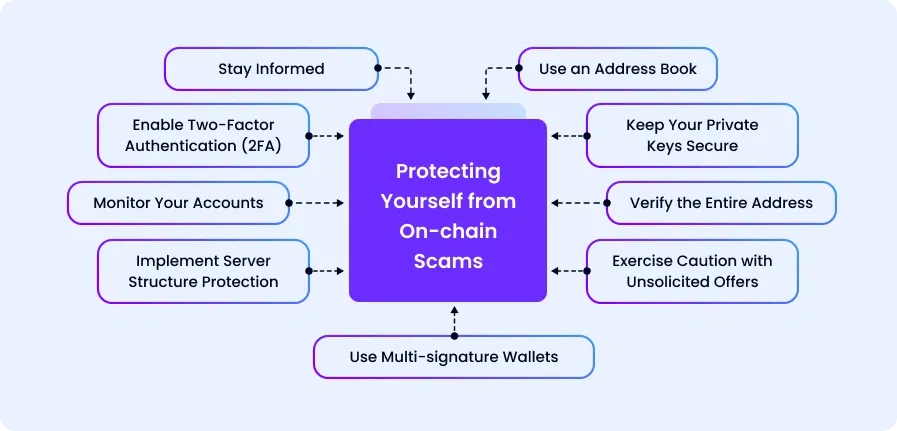The Risks of On-chain Transactions and How to Avoid Them
The Anatomy of an On-chain Scam
Scammers have become increasingly sophisticated in their methods, and understanding their tactics is crucial for safeguarding your digital assets. In this section, we will explore one such scam that has recently emerged, targeting high-value transactions and trade volumes.
The AirDrop Scam in Action
One recent example is a new type of AirDrop scam that targets high-value transactions and trade volume by airdropping tiny amounts of tokens to users' addresses. These attacker addresses are deceptively similar to the victim's address, tricking users into copying the wrong address from their transaction history and sending funds to the attacker.
In this scam, users' addresses are constantly airdropped with minuscule amounts of tokens (0.01 USDT, 0.001 USDT, etc.). The attacker's address has the same last few digits as the user's address, making it easy for users to accidentally send their funds to the attacker.
For example, one victim mistakenly sent 115,193 USDT to the wrong address, while another sent 345,940 USDT. In both cases, the attacker continued to airdrop tiny amounts of USDT to the victims using new addresses with the same ending characters.
Protecting Yourself from On-chain Scams
The best defense against on-chain scams is a combination of vigilance and knowledge. Let’s discuss practical steps you can take to safeguard your assets and avoid falling victim to these scams.
Verify the Entire Address
Before sending funds, double-check the entire recipient address. Scammers rely on users copying addresses from transaction history without verifying them. By ensuring the address is correct, you can avoid falling prey to these scams.
Use an Address Book
Most wallets offer an address book feature, allowing you to save frequently used addresses. Utilizing this feature can help prevent copying and pasting errors, reducing the likelihood of sending funds to the wrong address.
Stay Informed
Educate yourself about the latest scams to watch out for. That way, you can take the necessary precautions to keep your assets secure. Here are some resources to help you stay up to date with recent scams.
- CoinDesk: CoinDesk is a leading digital media platform covering news, insights, and analysis on cryptocurrencies, blockchain technology, and digital assets. They frequently report on scams and security breaches in the crypto space.
- CryptoSlate: CryptoSlate is a comprehensive news and data platform that provides updates on the latest cryptocurrency and blockchain news, including information on scams and fraudulent activities.
- Reddit: The r/Cryptocurrency subreddit is a community-driven platform where users share news, updates, and discuss various topics related to cryptocurrencies. Scam alerts and discussions about security incidents are frequently posted by the community members.
- Twitter: Follow trusted crypto influencers, security experts, and official accounts of popular cryptocurrency projects on Twitter for real-time updates on scams and other security concerns.Blockchain Security Blogs: Many blockchain security companies, such as SlowMist, regularly publish blog posts and updates on new vulnerabilities and scams in the cryptocurrency space.

Enable Two-Factor Authentication (2FA)
Two-factor authentication (2FA) provides an additional layer of security by requiring a second form of verification, such as a unique code generated by an app or sent via SMS, in addition to your password. By enabling 2FA on your wallet and exchange accounts, you can make it more difficult for scammers to access your funds.
Exercise Caution with Unsolicited Offers
As the old adage goes, “If the offer seems too good to be true, it probably is.”
Scammers often use social engineering tactics, such as offering fake investment opportunities or posing as support agents, to trick users into revealing sensitive information or sending funds. Always verify the legitimacy of any offers or requests before taking action.
Keep Your Private Keys Secure
Each user on the blockchain is given a unique set of keys called “private keys.” These keys keep your account secure from unauthorized access. Ensure that you store them securely and never share them with anyone. Consider using a hardware wallet, which keeps your private keys offline and protected from potential online threats.
Strengthening Your On-chain Security
Beyond protecting yourself from scams, it's essential to implement robust security measures for your digital assets. In this section, we will explore various strategies and technologies to help you fortify your on-chain security.
Implement Server Structure Protection
Securing your server is essential for safeguarding your digital assets. Implement server structure protection by using firewalls, intrusion detection systems, and robust encryption methods to prevent unauthorized access.
Use Multi-signature Wallets
Multi-signature wallets require more than one private key to authorize a transaction, adding an extra layer of security to your digital assets. In the event that one key is compromised, the attacker cannot access your funds without the other required keys.
Monitor Your Accounts
Regularly monitor your accounts and transactions to detect any suspicious activity. If you notice unauthorized transactions or receive airdrops from unfamiliar addresses, take immediate action to secure your assets.
Final Thoughts
On-chain transactions offer numerous benefits, but they also come with inherent risks. By understanding the threats and implementing security measures, you can protect yourself from scams and keep your digital assets secure. Remember to verify addresses, use address book features, stay informed about potential scams, and take the necessary steps to strengthen your on-chain security.
As the world of cryptocurrencies continues to evolve, staying up-to-date and proactive in your security efforts is more important than ever. Don't let yourself fall victim to scams. Take charge of your on-chain security today and invest in a safer, more prosperous future.
If you need advice on how to take the security of personal funds or your digital trading business to the next level, contact us.
Contact us


